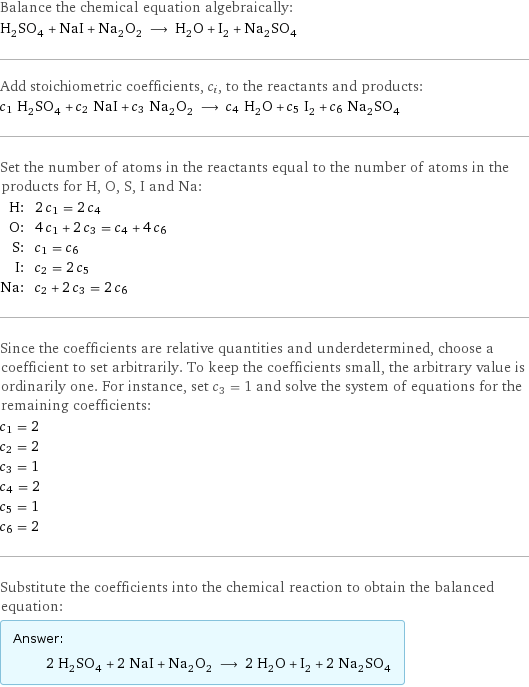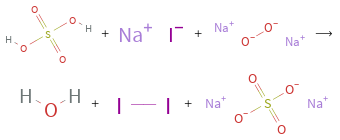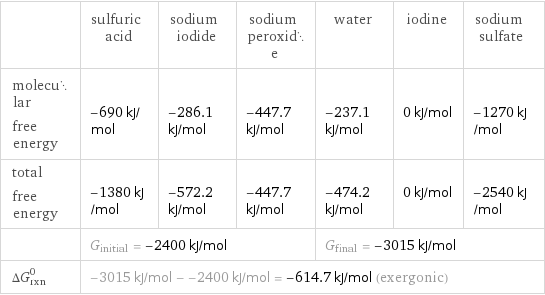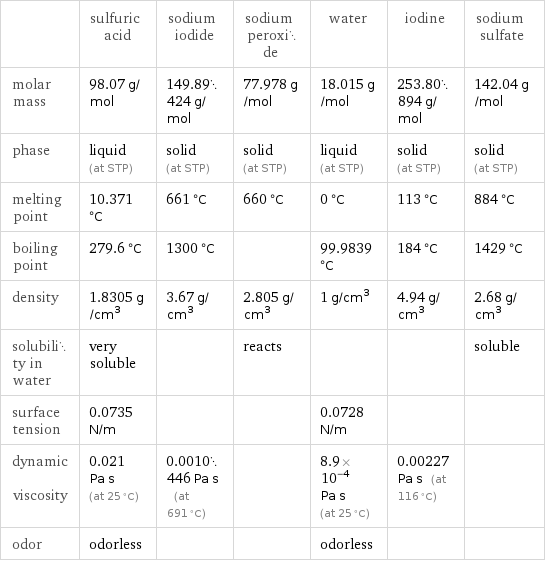Input interpretation

H_2SO_4 sulfuric acid + NaI sodium iodide + Na_2O_2 sodium peroxide ⟶ H_2O water + I_2 iodine + Na_2SO_4 sodium sulfate
Balanced equation

Balance the chemical equation algebraically: H_2SO_4 + NaI + Na_2O_2 ⟶ H_2O + I_2 + Na_2SO_4 Add stoichiometric coefficients, c_i, to the reactants and products: c_1 H_2SO_4 + c_2 NaI + c_3 Na_2O_2 ⟶ c_4 H_2O + c_5 I_2 + c_6 Na_2SO_4 Set the number of atoms in the reactants equal to the number of atoms in the products for H, O, S, I and Na: H: | 2 c_1 = 2 c_4 O: | 4 c_1 + 2 c_3 = c_4 + 4 c_6 S: | c_1 = c_6 I: | c_2 = 2 c_5 Na: | c_2 + 2 c_3 = 2 c_6 Since the coefficients are relative quantities and underdetermined, choose a coefficient to set arbitrarily. To keep the coefficients small, the arbitrary value is ordinarily one. For instance, set c_3 = 1 and solve the system of equations for the remaining coefficients: c_1 = 2 c_2 = 2 c_3 = 1 c_4 = 2 c_5 = 1 c_6 = 2 Substitute the coefficients into the chemical reaction to obtain the balanced equation: Answer: | | 2 H_2SO_4 + 2 NaI + Na_2O_2 ⟶ 2 H_2O + I_2 + 2 Na_2SO_4
Structures

+ + ⟶ + +
Names

sulfuric acid + sodium iodide + sodium peroxide ⟶ water + iodine + sodium sulfate
Reaction thermodynamics
Enthalpy

| sulfuric acid | sodium iodide | sodium peroxide | water | iodine | sodium sulfate molecular enthalpy | -814 kJ/mol | -287.8 kJ/mol | -510.9 kJ/mol | -285.8 kJ/mol | 0 kJ/mol | -1387 kJ/mol total enthalpy | -1628 kJ/mol | -575.6 kJ/mol | -510.9 kJ/mol | -571.7 kJ/mol | 0 kJ/mol | -2774 kJ/mol | H_initial = -2715 kJ/mol | | | H_final = -3346 kJ/mol | | ΔH_rxn^0 | -3346 kJ/mol - -2715 kJ/mol = -631.4 kJ/mol (exothermic) | | | | |
Gibbs free energy

| sulfuric acid | sodium iodide | sodium peroxide | water | iodine | sodium sulfate molecular free energy | -690 kJ/mol | -286.1 kJ/mol | -447.7 kJ/mol | -237.1 kJ/mol | 0 kJ/mol | -1270 kJ/mol total free energy | -1380 kJ/mol | -572.2 kJ/mol | -447.7 kJ/mol | -474.2 kJ/mol | 0 kJ/mol | -2540 kJ/mol | G_initial = -2400 kJ/mol | | | G_final = -3015 kJ/mol | | ΔG_rxn^0 | -3015 kJ/mol - -2400 kJ/mol = -614.7 kJ/mol (exergonic) | | | | |
Equilibrium constant
![Construct the equilibrium constant, K, expression for: H_2SO_4 + NaI + Na_2O_2 ⟶ H_2O + I_2 + Na_2SO_4 Plan: • Balance the chemical equation. • Determine the stoichiometric numbers. • Assemble the activity expression for each chemical species. • Use the activity expressions to build the equilibrium constant expression. Write the balanced chemical equation: 2 H_2SO_4 + 2 NaI + Na_2O_2 ⟶ 2 H_2O + I_2 + 2 Na_2SO_4 Assign stoichiometric numbers, ν_i, using the stoichiometric coefficients, c_i, from the balanced chemical equation in the following manner: ν_i = -c_i for reactants and ν_i = c_i for products: chemical species | c_i | ν_i H_2SO_4 | 2 | -2 NaI | 2 | -2 Na_2O_2 | 1 | -1 H_2O | 2 | 2 I_2 | 1 | 1 Na_2SO_4 | 2 | 2 Assemble the activity expressions accounting for the state of matter and ν_i: chemical species | c_i | ν_i | activity expression H_2SO_4 | 2 | -2 | ([H2SO4])^(-2) NaI | 2 | -2 | ([NaI])^(-2) Na_2O_2 | 1 | -1 | ([Na2O2])^(-1) H_2O | 2 | 2 | ([H2O])^2 I_2 | 1 | 1 | [I2] Na_2SO_4 | 2 | 2 | ([Na2SO4])^2 The equilibrium constant symbol in the concentration basis is: K_c Mulitply the activity expressions to arrive at the K_c expression: Answer: | | K_c = ([H2SO4])^(-2) ([NaI])^(-2) ([Na2O2])^(-1) ([H2O])^2 [I2] ([Na2SO4])^2 = (([H2O])^2 [I2] ([Na2SO4])^2)/(([H2SO4])^2 ([NaI])^2 [Na2O2])](../image_source/2d0df691dc066c6b2407fe4d2e02d2c5.png)
Construct the equilibrium constant, K, expression for: H_2SO_4 + NaI + Na_2O_2 ⟶ H_2O + I_2 + Na_2SO_4 Plan: • Balance the chemical equation. • Determine the stoichiometric numbers. • Assemble the activity expression for each chemical species. • Use the activity expressions to build the equilibrium constant expression. Write the balanced chemical equation: 2 H_2SO_4 + 2 NaI + Na_2O_2 ⟶ 2 H_2O + I_2 + 2 Na_2SO_4 Assign stoichiometric numbers, ν_i, using the stoichiometric coefficients, c_i, from the balanced chemical equation in the following manner: ν_i = -c_i for reactants and ν_i = c_i for products: chemical species | c_i | ν_i H_2SO_4 | 2 | -2 NaI | 2 | -2 Na_2O_2 | 1 | -1 H_2O | 2 | 2 I_2 | 1 | 1 Na_2SO_4 | 2 | 2 Assemble the activity expressions accounting for the state of matter and ν_i: chemical species | c_i | ν_i | activity expression H_2SO_4 | 2 | -2 | ([H2SO4])^(-2) NaI | 2 | -2 | ([NaI])^(-2) Na_2O_2 | 1 | -1 | ([Na2O2])^(-1) H_2O | 2 | 2 | ([H2O])^2 I_2 | 1 | 1 | [I2] Na_2SO_4 | 2 | 2 | ([Na2SO4])^2 The equilibrium constant symbol in the concentration basis is: K_c Mulitply the activity expressions to arrive at the K_c expression: Answer: | | K_c = ([H2SO4])^(-2) ([NaI])^(-2) ([Na2O2])^(-1) ([H2O])^2 [I2] ([Na2SO4])^2 = (([H2O])^2 [I2] ([Na2SO4])^2)/(([H2SO4])^2 ([NaI])^2 [Na2O2])
Rate of reaction
![Construct the rate of reaction expression for: H_2SO_4 + NaI + Na_2O_2 ⟶ H_2O + I_2 + Na_2SO_4 Plan: • Balance the chemical equation. • Determine the stoichiometric numbers. • Assemble the rate term for each chemical species. • Write the rate of reaction expression. Write the balanced chemical equation: 2 H_2SO_4 + 2 NaI + Na_2O_2 ⟶ 2 H_2O + I_2 + 2 Na_2SO_4 Assign stoichiometric numbers, ν_i, using the stoichiometric coefficients, c_i, from the balanced chemical equation in the following manner: ν_i = -c_i for reactants and ν_i = c_i for products: chemical species | c_i | ν_i H_2SO_4 | 2 | -2 NaI | 2 | -2 Na_2O_2 | 1 | -1 H_2O | 2 | 2 I_2 | 1 | 1 Na_2SO_4 | 2 | 2 The rate term for each chemical species, B_i, is 1/ν_i(Δ[B_i])/(Δt) where [B_i] is the amount concentration and t is time: chemical species | c_i | ν_i | rate term H_2SO_4 | 2 | -2 | -1/2 (Δ[H2SO4])/(Δt) NaI | 2 | -2 | -1/2 (Δ[NaI])/(Δt) Na_2O_2 | 1 | -1 | -(Δ[Na2O2])/(Δt) H_2O | 2 | 2 | 1/2 (Δ[H2O])/(Δt) I_2 | 1 | 1 | (Δ[I2])/(Δt) Na_2SO_4 | 2 | 2 | 1/2 (Δ[Na2SO4])/(Δt) (for infinitesimal rate of change, replace Δ with d) Set the rate terms equal to each other to arrive at the rate expression: Answer: | | rate = -1/2 (Δ[H2SO4])/(Δt) = -1/2 (Δ[NaI])/(Δt) = -(Δ[Na2O2])/(Δt) = 1/2 (Δ[H2O])/(Δt) = (Δ[I2])/(Δt) = 1/2 (Δ[Na2SO4])/(Δt) (assuming constant volume and no accumulation of intermediates or side products)](../image_source/934bfe0994f92486430312e93b6599a1.png)
Construct the rate of reaction expression for: H_2SO_4 + NaI + Na_2O_2 ⟶ H_2O + I_2 + Na_2SO_4 Plan: • Balance the chemical equation. • Determine the stoichiometric numbers. • Assemble the rate term for each chemical species. • Write the rate of reaction expression. Write the balanced chemical equation: 2 H_2SO_4 + 2 NaI + Na_2O_2 ⟶ 2 H_2O + I_2 + 2 Na_2SO_4 Assign stoichiometric numbers, ν_i, using the stoichiometric coefficients, c_i, from the balanced chemical equation in the following manner: ν_i = -c_i for reactants and ν_i = c_i for products: chemical species | c_i | ν_i H_2SO_4 | 2 | -2 NaI | 2 | -2 Na_2O_2 | 1 | -1 H_2O | 2 | 2 I_2 | 1 | 1 Na_2SO_4 | 2 | 2 The rate term for each chemical species, B_i, is 1/ν_i(Δ[B_i])/(Δt) where [B_i] is the amount concentration and t is time: chemical species | c_i | ν_i | rate term H_2SO_4 | 2 | -2 | -1/2 (Δ[H2SO4])/(Δt) NaI | 2 | -2 | -1/2 (Δ[NaI])/(Δt) Na_2O_2 | 1 | -1 | -(Δ[Na2O2])/(Δt) H_2O | 2 | 2 | 1/2 (Δ[H2O])/(Δt) I_2 | 1 | 1 | (Δ[I2])/(Δt) Na_2SO_4 | 2 | 2 | 1/2 (Δ[Na2SO4])/(Δt) (for infinitesimal rate of change, replace Δ with d) Set the rate terms equal to each other to arrive at the rate expression: Answer: | | rate = -1/2 (Δ[H2SO4])/(Δt) = -1/2 (Δ[NaI])/(Δt) = -(Δ[Na2O2])/(Δt) = 1/2 (Δ[H2O])/(Δt) = (Δ[I2])/(Δt) = 1/2 (Δ[Na2SO4])/(Δt) (assuming constant volume and no accumulation of intermediates or side products)
Chemical names and formulas

| sulfuric acid | sodium iodide | sodium peroxide | water | iodine | sodium sulfate formula | H_2SO_4 | NaI | Na_2O_2 | H_2O | I_2 | Na_2SO_4 Hill formula | H_2O_4S | INa | Na_2O_2 | H_2O | I_2 | Na_2O_4S name | sulfuric acid | sodium iodide | sodium peroxide | water | iodine | sodium sulfate IUPAC name | sulfuric acid | sodium iodide | disodium peroxide | water | molecular iodine | disodium sulfate
Substance properties

| sulfuric acid | sodium iodide | sodium peroxide | water | iodine | sodium sulfate molar mass | 98.07 g/mol | 149.89424 g/mol | 77.978 g/mol | 18.015 g/mol | 253.80894 g/mol | 142.04 g/mol phase | liquid (at STP) | solid (at STP) | solid (at STP) | liquid (at STP) | solid (at STP) | solid (at STP) melting point | 10.371 °C | 661 °C | 660 °C | 0 °C | 113 °C | 884 °C boiling point | 279.6 °C | 1300 °C | | 99.9839 °C | 184 °C | 1429 °C density | 1.8305 g/cm^3 | 3.67 g/cm^3 | 2.805 g/cm^3 | 1 g/cm^3 | 4.94 g/cm^3 | 2.68 g/cm^3 solubility in water | very soluble | | reacts | | | soluble surface tension | 0.0735 N/m | | | 0.0728 N/m | | dynamic viscosity | 0.021 Pa s (at 25 °C) | 0.0010446 Pa s (at 691 °C) | | 8.9×10^-4 Pa s (at 25 °C) | 0.00227 Pa s (at 116 °C) | odor | odorless | | | odorless | |
Units
